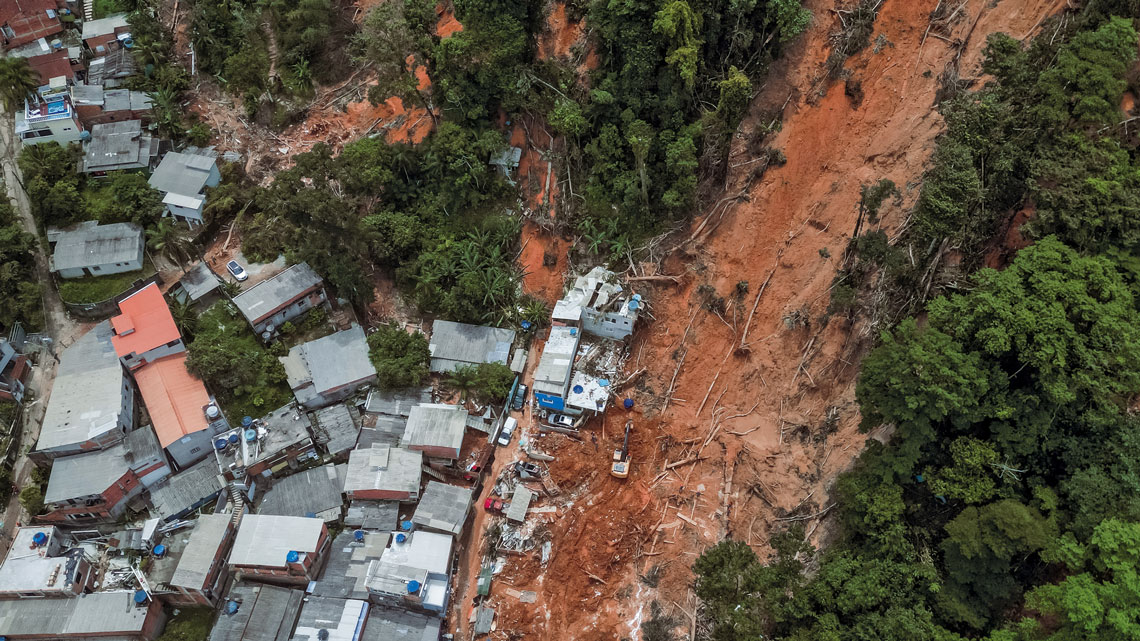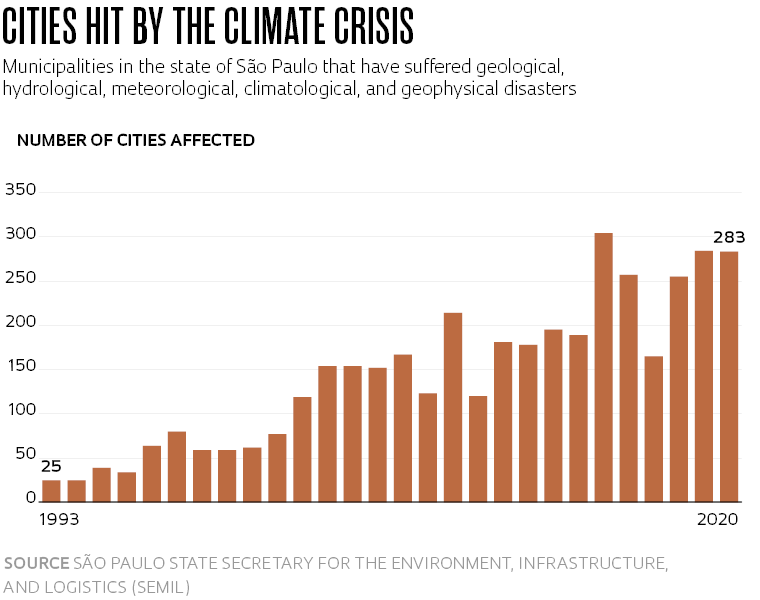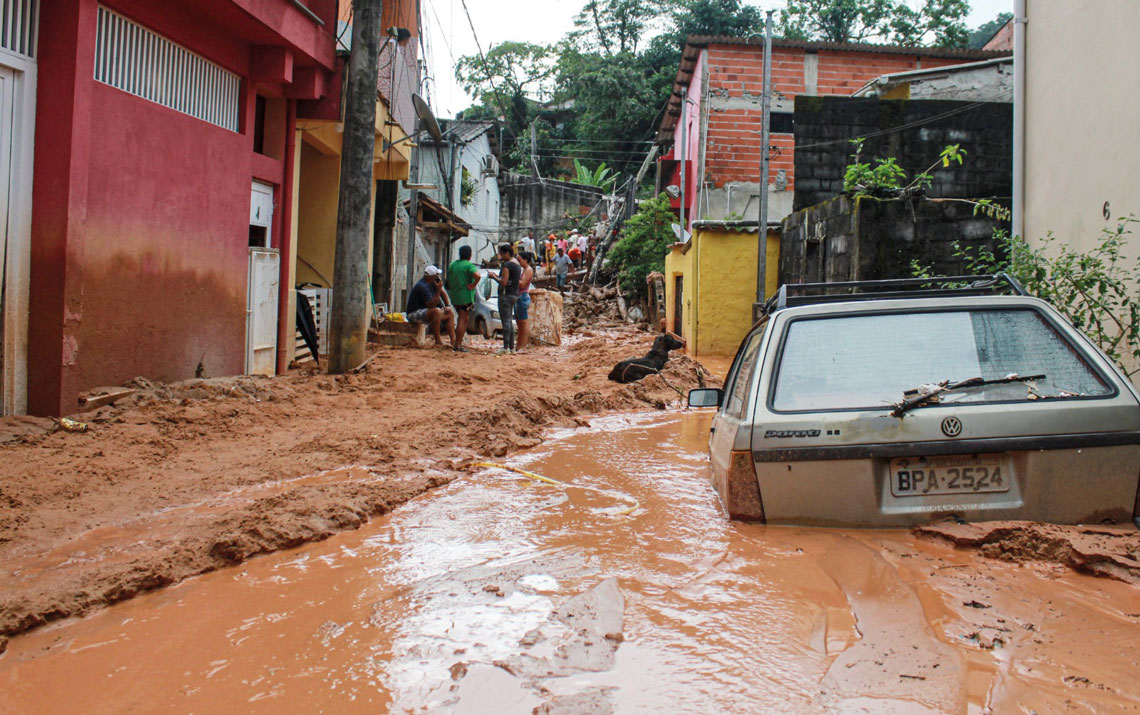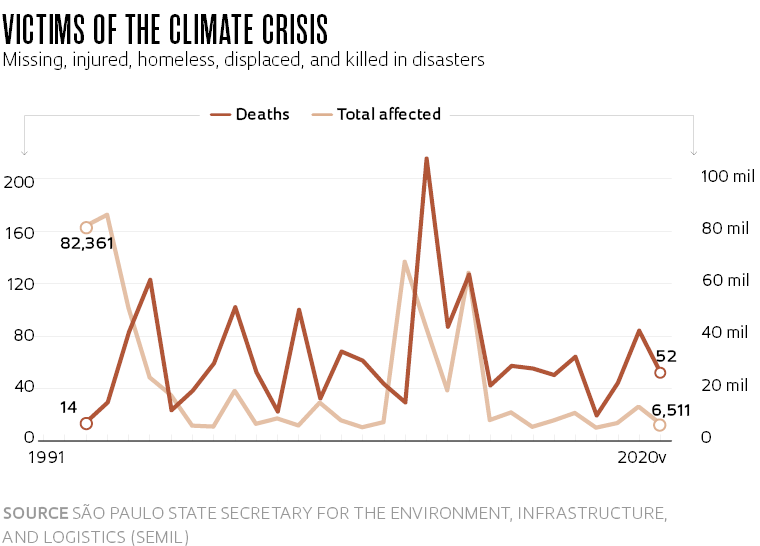In 1993, the number of geological, hydrological, meteorological, climatological, and geophysical disasters recorded in the state of São Paulo was 297. In 2020, it was 2,800. The number of municipalities affected by this type of event also increased, from 25 in 1993 to 283 in 2020, according to data from the São Paulo State Secretary for the Environment, Infrastructure, and Logistics (SEMIL). According to the organization Local Governments for Sustainability (ICLEI), fewer than 50 Brazilian cities have adaptation plans—a strategic document seen as an essential tool for combating the increasingly intense effects of the climate crisis. Furthermore, in São Paulo, municipal master plans are drawn up based solely on historical data, without taking into account the projections of major changes in the characteristics of climatic events over the coming years.
The concept of a disaster describes an adverse natural or man-made event and its impacts on an ecosystem, lives, property, and the environment, as well as the economic and social damage. In the state of São Paulo, deaths associated with disasters began being recorded in 1991, a year in which there were no deaths, according to official government data. In 2020, there were 52 disaster-related deaths, and the years with the highest number of fatalities, according to SEMIL, were 2009 and 2011. The total number of people affected by these events—including all people injured, displaced, or missing—was 6,500 in 2020 (see graph on page 56). A survey by the Brazilian Center for Natural Disaster Monitoring (CEMADEN) indicates that 2,200 Brazilian cities home to 70% of the country’s population are vulnerable to climate disasters related to extreme rainfall. Ubatuba and São Sebastião, on the coast of São Paulo, both feature on this list.
Jussara de Lima Carvalho, a chemical engineer from SEMIL, points out that according to a 2002 report by the United Nations (UN), 68% of the world’s population will live in cities by 2050, and that medium-sized towns in developing countries like Brazil are growing the fastest. “Climate change will continue to impact the environment and will lead to increasingly extreme events. We need to see the current moment as an opportunity to rethink the development of urban environments,” argues Carvalho.
Although few ideas have left the drawing board, Brazil has created tools to help state and municipal managers establish effective strategies. One is the National Adaptation Plan (NAP), established in 2016 with the aim of reducing the nation’s vulnerability to climate change. The national document offers guidance on risk management in 11 different sectors, including agriculture, coastal zones, and biodiversity. “But the NAP is not enforced by law. The implementation of its actions is thus at the discretion of each state and municipality,” explains Ivan Carlos Maglio, a civil engineer from the Institute of Advanced Studies at the University of São Paulo (IEA-USP). He notes that the first Brazilian initiatives to combat the effects of the climate crisis involved controlling greenhouse gas emissions, a trend that changed—especially after 2015—when scientific studies showed that measures were needed to adapt to these impacts rather than trying to stop them. According to Gabriela Marques Di Giulio, a professor at USP’s School of Public Health, the 2015 United Nations Conference on Climate Change (COP) represented a significant milestone in this change of approach. “From the moment the effects began more starkly impacting day-to-day city life, the international debate switched to how to mitigate the losses and damages associated with the climate crisis,” she explains.
In the state of São Paulo, the starting point for risk and disaster management policies was a preventive plan drawn up by the Civil Defense in 1989 for controlling landslides in the Serra do Mar mountains of Santos, Cubatão, Guarujá, and São Vicente. In 2009, the State Policy on Climate Change was enacted through Law No. 13,798. In 2022, the state approved and published the 2050 Climate Action Plan, which featured contributions from researchers associated with the FAPESP-funded Biota Síntese program and which also involves members of the state government. “We proposed strategies to promote ecological restoration in urban areas and so-called peri-urban areas in the state,” says the researcher.
According to Di Giulio, these peri-urban areas, which account for 3% of the state’s total area, are highly vulnerable to climate impacts due to deforestation, land use pressure, and illegal occupation. “At the same time, they have great potential to provide ecosystem services,” she says. Ecosystem services are benefits provided to humans by the natural functioning of ecosystems.
According to SEMIL geologist Claudio José Ferreira, around 100 municipalities have mapped risks in their territories, while the state as a whole has at least one regional assessment. “The challenge now is to incorporate climate projections into these maps. We are supporting some municipalities to write adaptation plans with this new focus,” he says.
As part of the endeavor, the Resilient Municipalities of São Paulo program was created in 2020, providing training on the creation of adaptation plans to 12 towns in 2022, including Americana, Embu das Artes, and Ubatuba. “One of the central focuses of these workshops was to highlight the importance of incorporating future climate change scenarios into public policies, including an increase in the Earth’s temperature and a higher incidence of rainfall by 2050. Historical data are no longer enough for designing effective actions,” emphasizes Carvalho. Eight of the participating towns and the Metropolitan Region of Baixada Santista completed adaptation plans incorporating these guidelines.
Ferreira highlights that the Federal Constitution of 1988 established a requirement for municipal master plans, which are regulated by Law No. 10,257, of 2001. He notes that many municipalities include risk management in their master plans, as is the case in Mogi Mirim, which has just reformulated its own. “The problem is that their risk analyses consider climatological measures until 2020, which is not enough to deal with the extreme events predicted in recent projections,” he warns. Emphasizing the urgent need to invest in public policies that consider future scenarios, the geologist points out that in the 1990s, environmental disasters were mostly restricted to the Serra do Mar region. In the last two years, however, their effects have been felt in more than 500 towns across the state, which now face erosion, landslides, and flooding.
Maglio, from USP, says that São Sebastião does not have an adaptation plan, but its new master plan, approved in 2021, establishes that 101 illegally occupied areas are to be turned into Special Social Interest Zones (ZEISs). The engineer, who acted as a consultant for the document, explains that it used data from 2017 to identify geotechnical risks, determining that these ZEISs, which have a total population of around 25,000 people, require urgent intervention to prevent the occurrence of disasters. “The development of the master plan did not involve any predictions about the future. The vulnerabilities of these areas to landslides and floods are even more intense when you look at future scenarios,” he warns, citing the municipalities of Santos, Recife, Rio de Janeiro, São Paulo, and Salvador as examples of adaptation plans that incorporate projections.
Lessons from Bangladesh
Despite recognizing that the delay in creating adaptation plans is common worldwide, USP economist and sociologist Pedro Roberto Jacobi believes Brazil lacks a culture of prevention. “Brazilian municipalities in vulnerable regions should invest in alert systems, for example, as a way of anticipating the occurrence of extreme events,” argues Jacobi, who is also president of ICLEI for South America. He mentions that other places in the Global South are also dealing with the effects of the climate crisis, such as Bangladesh, where storms periodically “make half the country disappear under water.” Sociologist Pedro Henrique Campello Torres, who is carrying out postdoctoral research at IEA-USP with funding from FAPESP, explains that cyclones and storms passing through the South Asian country used to cause a high number of deaths, such as Cyclone Bhola, which resulted in more than 300,000 deaths in 1970. Since then, the nation has invested in risk and disaster prevention and reduction, and the number of deaths has been reduced 100-fold.
Over the past two years, roughly 7% of Bangladesh’s budget has been allocated to combating the effects of climate change. The country now has 14,000 shelters capable of providing emergency accommodation to around 2.4 million people, 50 meteorological stations, and an alert system that issues warnings in mosques, on the radio and television, and through text messages, as well as a network of volunteers who go house to house to warn people. The topic of climate risk is also taught in school. Despite the advances the country has made, Torres stresses that it continues to face difficulties rebuilding its infrastructure after major storms.
The sociology of disaster, a field of study that focuses on analyzing the long-term effects of disastrous events and their impacts on society, emerged in Europe and the USA in the 1970s and has been gaining interest in Brazil since the 1990s. Economist Norma Valencio of the Federal University of São Carlos (UFSCar), one of the pioneers in the field, points out that its contributions and analyses are essential to combating the worsening climate crisis. “In the last 15 years, public policies on disaster management have been based on knowledge produced by fields such as geology, physical geography, meteorology, and climatology, which do not place enough attention on a long-term understanding of the social structure and dynamics of locations susceptible to risks or the people affected,” she says.
According to Valencio, the sociology of disaster also analyzes the influence the military has on Brazilian civil defense agencies and how they deal with these kinds of events. Since it was created in the 1990s, the country’s civil defense system has delegated command to police officers, firefighters, or military reserve forces. “The hierarchy of command and obedience in the armed forces puts a strain on the local cultural repertoire and the means of sociability in the communities,” she says. When investigating shelters in the mountainous region of Rio de Janeiro after major storms in 2011 left more than 900 people dead, CEMADEN sociologist Victor Marchezini observed that curfews and the presence of armed police made the homeless feel unsafe, especially women, who feared sexual harassment. Marchezini led a study on civil defense in 1,993 Brazilian municipalities, identifying the precarious nature of the financial and human resources that supported these institutions. “Through our research we found that less than 10% of civil defense agencies had community centers and that 80% of their agents were male,” says the sociologist. Marchezini maintains that working closely with communities is fundamental to the interpretation of meteorological data, which need to be contextualized within different local situations.
Projects
1. Environmental governance of the São Paulo macro-metropolis in response to climate variability (nº 15/03804-9); Grant Mechanism Global Climate Change Research Program; Principal Investigator Pedro Roberto Jacobi (USP); Investment R$5,687,318.22.
2. New methods of scientific cooperation for innovation in socio-environmental governance in the São Paulo macro-metropolis (nº 18/06685-9); Grant Mechanism Postdoctoral Fellowship; Supervisor Pedro Roberto Jacobi (USP); Beneficiary Pedro Henrique Campello Torres; Investment R$668,947.23.
3. Biota Síntese ‒ Center for analysis and synthesis of nature-based solutions (nº 20/06694-8); Grant Mechanism Biota Program ‒ Problem-oriented research centers in São Paulo; Principal Investigator Jean Paul Walter Metzger (USP); Investment R$3,656,164.10.
4. Multidisciplinary research methods in risk and disaster scenarios: Subsidies for the formulation of warning systems centered on people and multi-threats (nº 18/06093-4); Grant Mechanism Postdoctoral Fellowship; Principal Investigator Victor Marchezini (CEMADEN); Investment R$247,301.50.
5. Achieving Sustainable Development Goals in the context of disaster response (CODeS): Computational tools in integrated data analysis (nº 22/09136-1); Grant Mechanism Regular Research Grant ‒ eScience and Data Science Program; Principal Investigator Norma Felicidade Lopes da Silva Valencio (UFSCar); Investment R$102,617.59.
Scientific articles
COUTINHO, S. M. V. et al. Adaptação às mudanças climáticas no Brasil: Complexidade, incertezas e estratégias existentes. Revista ClimaCom. 8, 20. 2021.
DI GIULIO, G. et al. Bridging the gap between will and action on climate change adaptation in large cities in Brazil. Regional Environmental Change. 19, pp. 2491–502. 2019.
Books
TORRES, P. H. C & JACOBI, P. R. (eds.). Towards a just climate change resilience. Switzerland: Palgrave Macmillan, 2021.
MARCHEZINI, V. (org.). Diagnóstico de capacidades e necessidade municipais em proteção e defesa civil. Brasília: Ministry of Regional Development, 2021.
VALENIO, N. et al. Abandonados nos desastres: Uma análise sociológica de dimensões objetivas e simbólicas de afetação de grupos sociais desabrigados e desalojados. Brasília: Conselho Federal de Psicologia, 2011.
Report
World Cities Report 2022 – Envisaging the future of cities. united nations human settlements programme (UN-Habitat), 2022.
Republish



